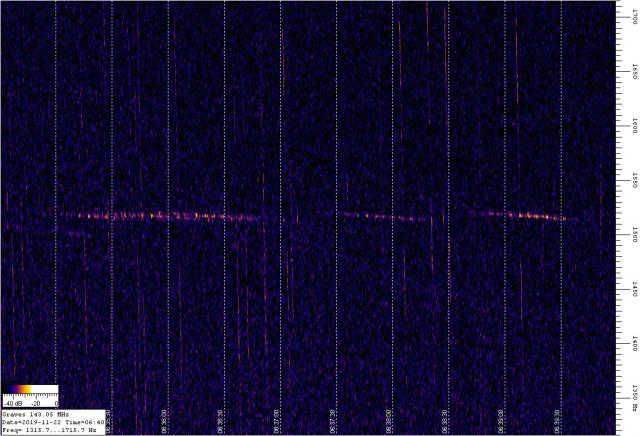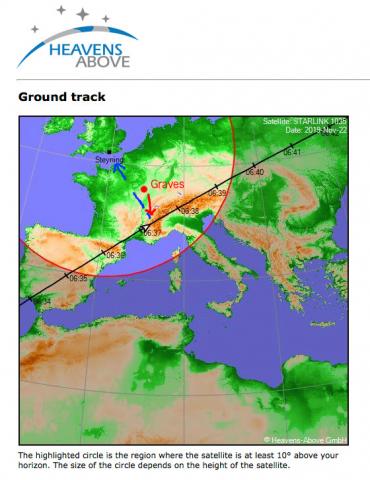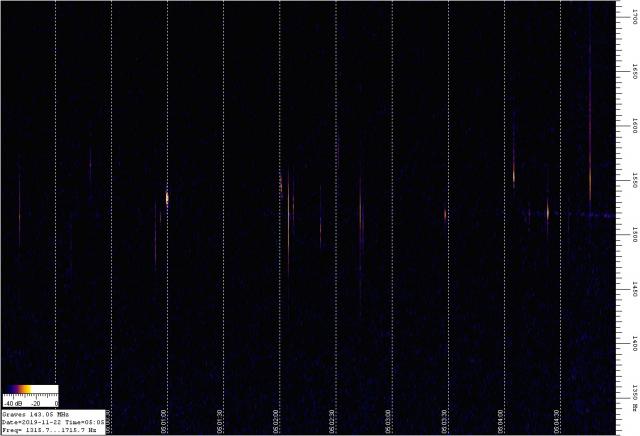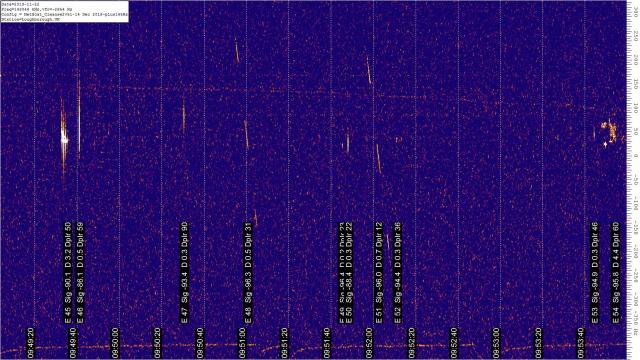› Forums › Radio Astronomy › Starlink satellites detected by radio reflection
- This topic has 3 replies, 3 voices, and was last updated 4 years, 5 months ago by
 Nick Quinn.
Nick Quinn.
-
AuthorPosts
-
24 November 2019 at 7:00 pm #574450
 Nick QuinnParticipant
Nick QuinnParticipantIt appears that the SpaceX Starlink satellites have the potential to disrupt forward-scatter radio meteor detection systems as well as ‘photo-bomb’ our astrophotographs! My forward-scatter system was operational on Friday morning to monitor the alpha Monocerotid meteors (a slight enhancement noted around 05.00 hrs., see last image below) and between 06.14 hrs and 06:39 hrs picked up reflections from over 30 of the Starlink satellites.
The screenshots from Spectrum Lab show time along the x-axis (vertical lines every 30 secs) and frequency in hertz along the y-axis. I am close enough to the GRAVES radar station (near Dijon, France) that the direct signal (from the back of the antenna array) fades in and out. It shows across the middle of the plot and is effectively the zero-doppler reference frequency.
The satellites can be distinguished from meteors as the doppler trails are slightly off-vertical due to the radar signal being reflected for several seconds, much longer than sub-second meteor ‘pings’.

Note that the next plot has a higher background noise level as my internet router switches on at 6.30 hrs!

Here is the ground-track for one of the Starlink satellites (from Heavens Above https://www.heavens-above.com) onto which I have added the (very) approximate position of GRAVES and the signal path to my receiver.

Possible alpha Monocerotid reflections:
 25 November 2019 at 8:36 am #581644
25 November 2019 at 8:36 am #581644John Cook
ParticipantThese satellites sound like a real problem for all aspects of astronomy. At least they are clearly different to the real meteor reflections, and so can be ignored. It is good to know that the predicted meteor peak was detected and recorded.
25 November 2019 at 12:58 pm #581646 Derek RobsonParticipant
Derek RobsonParticipantHi Nick
Some interesting observations. If the almost vertical slotted lines are the satellites, then what are the thicker almost horizontal lines? My system had been picking up slotted curved lines with a rough angle of 45-60 degrees relative to the horizontal, which are probably satellites. But meteors on the system show up a fleeting pings which are vertical, and the longer duration ones tend to be asymmetrical, sometimes have a E shape and sometimes a spiral extension. Occasionally I see lines which wander above and below the zero hertz frequency line (Y=0), and sometimes they are solid or dotted – I think these are certain beacon transmissions. But I’ve not seen examples of what you are detecting showing almost horizontal lines with a slight slope, then repeats itself.
In the image I’ve uploaded, you can see the satellites are interfering with the software’s meteor recognition causing inflated count rates, which are difficult to manage by manual subtraction methods, which are time-consuming and not practical.
 25 November 2019 at 9:09 pm #581649
25 November 2019 at 9:09 pm #581649 Nick QuinnParticipant
Nick QuinnParticipantDerek,
Yes, I can see that your automatic counting is compromised by satellite reflections. i wonder if it may be possible to use any of the Spectrum Lab interpreter’s many features to weed them out? Probably it’s a case of exporting the results of the FFT calculations and processing them through another piece of software!
Regarding the horizontal lines, as I said I am close enough that a slight ‘lift’ will bring in the direct signal. I also get reflections from aircraft flying in and of the airports in the Dijon area which show very small doppler shifts. Sometimes higher flying aircraft moving at greater velocities show larger doppler shifts. The ‘dotted’ traces are due to the radar beam pattern switching direction every few seconds
I wouldn’t have thought there would be any beacons operating on or near to the GRAVES frequency but the software does vividly highlight any and all local interference! Recently my X10 mains switching system started becoming unreliable and I was able to pin down the culprit as a failing switch-mode PSU that was generating a lot of noise at 120kHz.
-
AuthorPosts
- You must be logged in to reply to this topic.
